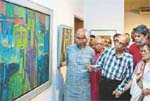 Bengal Gallery of Fine Arts in Dhanmondi has organised a special solo art exhibition titled “Tribute to Great Master Safiuddin Ahmed”, featuring works of the recently deceased artist Safiuddin Ahmed.
Bengal Gallery of Fine Arts in Dhanmondi has organised a special solo art exhibition titled “Tribute to Great Master Safiuddin Ahmed”, featuring works of the recently deceased artist Safiuddin Ahmed.
Begum Jahanara Abedin (widow of Zainul Abedin) inaugurated the exhibition on June 5 as chief guest. Painter Qayyum Chowdhury; educationist Borhanuddin Khan Jahangir; writer and poet Syed Shamsul Haq; artist Rafiqun Nabi and Professor Abul Mansur, Institute of Fine Arts, Chittagong University spoke on the occasion.
Subir Chowdhury, director, Bengal Gallery of Fine Arts, and Ahmed Nazir (son of Safiuddin Ahmed) also spoke at the opening programme.
The discussants talked about Safiuddin’s life, work and contribution to Bangladeshi art. They collectively expressed the view that Safiuddin was not only a great printmaker, but also an accomplished painter. The death of Safiuddin was a great loss for the Bangladeshi art scene. He was a major inspiration for contemporary artists.
About 70 artworks (paintings and prints) are on display at the exhibition. Safiuddin mainly focused on rural panorama and way of life, landscapes, flood and other natural calamities, Santals, Liberation War as well as the Language Movement. The exhibition also features portraits, still life, drawings and more. Black is the noticeable shade in most of his paintings and prints at the exhibition. As an experimental artist, he made use of varied geometrical patterns and shapes as symbolic modes of expressions.
Safiuddin was born in 1922 in Calcutta (now Kolkata), India. He was a student of Calcutta Government School of Art and graduated from the institute in 1942. After Partition in 1947, Safiuddin left Calcutta for Dhaka, where he found himself caught up in a movement to set up the first art institute in the then East Pakistan. He was a friend and colleague of Shilpacharya Zainul Abedin. He was one of the founders of Dacca Art College (now the Faculty of Fine Arts, University of Dhaka). From 1948 to 1979, he served as head of the department of printmaking at the institute.
Some of his outstanding achievements as a young artist included the President’s Gold Medal (1945) by Academy of Fine Arts, Calcutta; first prize in the category of black and white in International Contemporary Art Exhibition, New Delhi (1946); first prize in the category of black and white (etching and drawing) in Inter-Asian Art Exhibition in New Delhi (1947) and Patna Maharaja’s Gold Medal (1947). He was a recipient of the Ekushey Padak and Shadhinota Puroshkar.
-With The Daily Star input




















